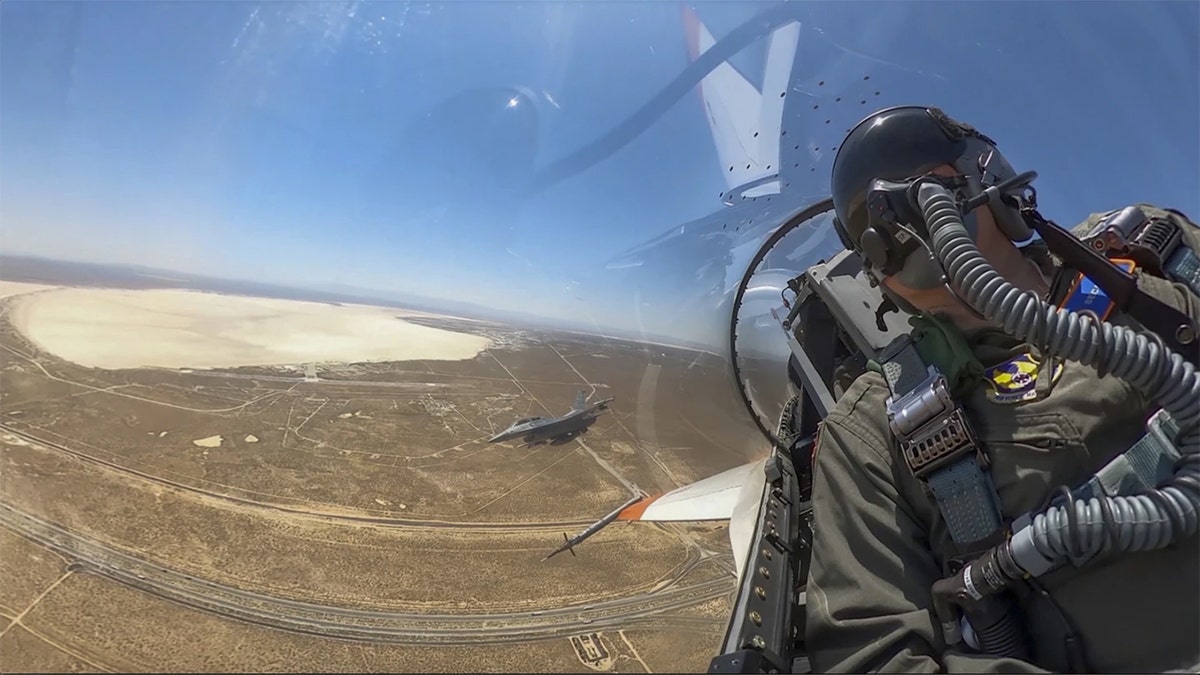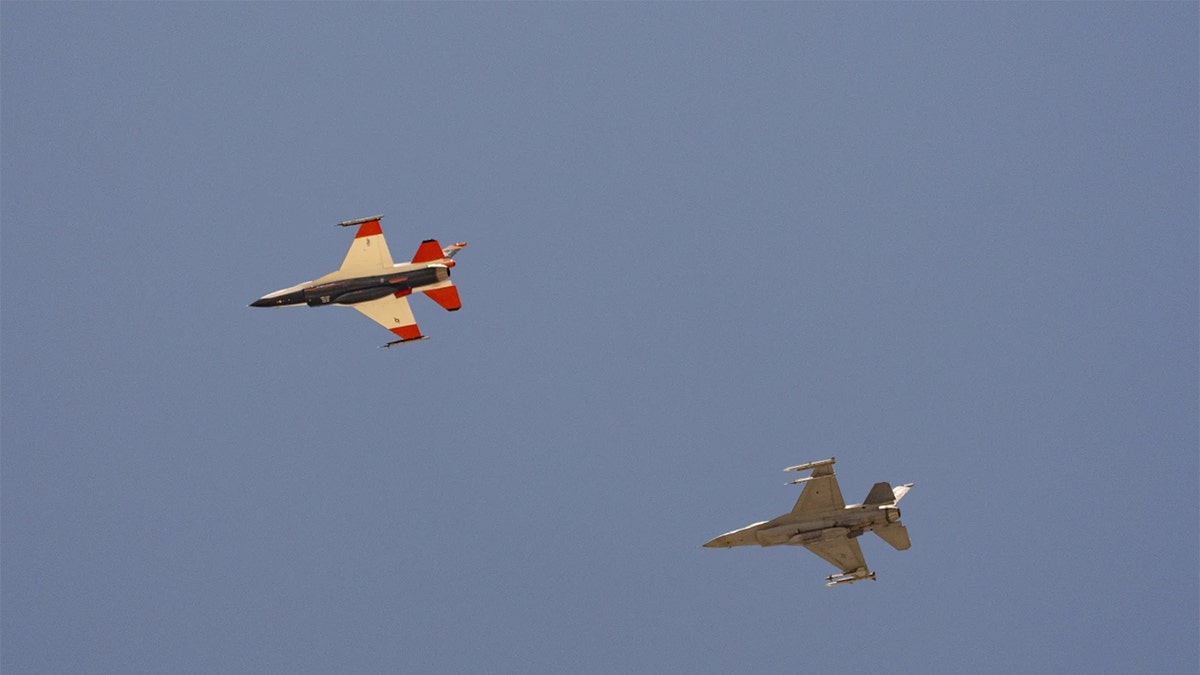U.S. Air Force Secretary Frank Kendall takes flight in AI-controlled F-16
U.S. Air Force Secretary Frank Kendall took a history-making flight in an AI-controlled F-16 on May 3, 2024.
Fulfilling a bold promise to the Senate, Secretary of the Air Force Frank Kendall put himself in the cockpit and let AI take over and fly an F-16 through an hour of aerial engagements and dogfights near Edwards Air Force Base, California.
There’s just one reason Kendall, age 74, a West Point graduate and career Army officer, took that flight.
Deterring China. America’s top priority right now is to make sure the U.S., not China, leads in AI. The U.S. Air Force just took a big step in the right direction.
Not that it wasn’t fun. Judging from the big smile on Kendall’s face, it was a heck of a flight.

This image from remote video released by the U.S. Air Force shows Air Force Secretary Frank Kendall during his experimental flight inside the cockpit of a X-62A VISTA aircraft autonomous warplane above Edwards Air Base, Calif, on Thursday, May 2, 2024. (AP Photo/Damian Dovarganes)
To be clear, the highly modified F-16 known as the X-62 Vista was a two-seat version with a highly experienced pilot in the back seat. The take-off and landing were hand-flown.
Kendall in the Vista F-16 flew to the restricted airspace training ranges east of Bakersfield and west of the Nevada border. There, pilots can go supersonic, carry out simulated bombing runs, and of course, dogfight. Once the exercise began, another F-16 playing the opponent would try to gain position advantage on the Vista. Kendall and the backseat pilot were basically spectators, watching cockpit instruments as the AI agents gave the control inputs and made the tactical decisions.
"We turn the automation on and let it control the airplane for some period of time," Kendall said, for "a minute or two. Then you turn it back off."
Just let me add, a minute or two is an eternity in air combat. Korean War jet aces like Capt. Joseph McConnell shot down multiple enemy MiGs in seconds.

An AI-enabled Air Force F-16 fighter jet, left, flies next to an adversary F-16, as both aircraft race within 1,000 feet of each other, trying to force their opponent into vulnerable positions, on Thursday, May 2, 2024, above Edwards Air Force Base, Calif. (AP Photo/Damian Dovarganes)
While the AI was flying, the horizon tilted back and forth as it fought. The F-16 bubble canopy gives almost a 360-degree view and good visibility under the plane. Kendall got quite a view.
I’m impressed that Kendall was keen to let an AI agent yank and bank him through combat maneuvers pulling five times the force of gravity. In my experience in one F-16 wargame flight in Alaska, you can take the G force loads as they bear down and scrunch your body as the plane turns fast. It’s the unloading of Gs that gives you the out-of-control, freefall feeling.
Of course, pulling up to 9Gs is just another day at the office for F-16 test pilots. They maneuver to win; it’s dramatic, but it’s basically a tactic. Kendall’s flight suggests the days of pulling Gs are coming to a close.
This was no spontaneous joyride. Granted, America’s top fighters already have a lot of automation in their flight controls and tactical systems. The F-16 was born fly-by-wire; it’s actually slightly unstable in flight without computer guidance.

Air Force Secretary Frank Kendall smiles after a test flight of the X-62A VISTA aircraft against a human-crewed F-16 aircraft in the skies above Edwards Air Force Base, Calif., on Thursday, May 2, 2024. (AP Photo/Damian Dovarganes)
This special F-16 has been flying AI test sorties since late 2022. A rectangular component behind the cockpit contains the AI computer "sandbox" as the test pilots call it. The two regular drivers of the Vista F-16 are nicknamed Fangs and Evil. Very cool callsigns. Perhaps more relevant, the callsign for one of the lieutenant colonels in charge of the program was "Hal." You guessed it. Like the thinking computer in "2001: A Space Odyssey."
An AI dogfight, with a civilian up front, opens a new chapter.
Yes, this is pretty much the end of an era for one-man aerial combat. Not right away. Many missions, from F/A-18s tracking Houthi drones over the Red Sea, to the F-35s that can carry tactical nuclear weapons, absolutely require pilots.
The future Air Force is going to look a lot different.

The X-62A VISTA aircraft, an experimental AI-enabled Air Force F-16 fighter jet, takes off on Thursday, May 2, 2024, at Edwards Air Force Base, Calif. The flight, with Air Force Secretary Frank Kendall riding in the front seat, serves as a public statement of confidence in the future role of AI in air combat. (AP Photo/Damian Dovarganes)
Kendall is leading the Air Force toward 1,000 or more unmanned combat AI planes, with the first operational in 2028. Last month, Kendall selected Anduril and General Atomics as winners to build the next round of Collaborative Combat Aircraft drones. The Pentagon will also accelerate fielding of the AeroVironment Switchblade-600 loitering munition as part of Deputy Secretary of Defense Kathleen Hick’s Replicator initiative.
CLICK HERE FOR MORE FOX NEWS OPINION
You may be surprised to hear that the next steps in AI also depend on gut feel. Trust is key. The Air Force’s goal is smooth, trusted AI teamed with humans in the loop. Previous work with small L-29 jet planes monitored physiological responses of pilots, to see whether they were trusting the AI actions, or getting nervous as the AI made tactical decisions. AI flights still have plenty of safety checks and guardrails in place.
"I wasn’t terribly worried about the risk of the autonomy," Kendall said after his flight.
Yes, this is pretty much the end of an era for one-man aerial combat. Not right away. Many missions, from F/A-18s tracking Houthi drones over the Red Sea, to the F-35s that can carry tactical nuclear weapons, absolutely require pilots.
Kendall also said he’d trust AI to decide to fire weapons autonomously. Don’t forget the Air Force has long operated with Beyond Visual Range (BVR) missiles which rely on radar, infrared and other sensor data. Still, it’s a stunning statement. Apparently, the AI was good enough to verify the "enemy" plane identity and get in position for a legitimate shot during the simulation. And as AI improves, there will still be a big human team involved, starting with the ground crews who maintain, prep, and arm aircraft.
CLICK HERE TO GET THE FOX NEWS APP
Fast progress in AI is essential for national security. China is "a competitor with national purchasing power that exceeds our own, a challenge we have never faced in modern times," Kendall told the Senate on Apr. 9.
As Warren Buffett recently said of AI, "it's going to be done by somebody." Hats off to American industry and the U.S. Air Force for seizing the lead.






















